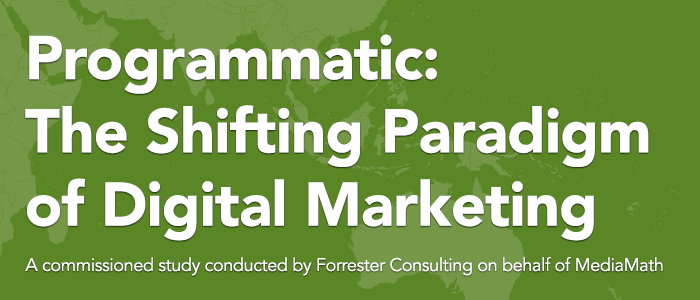CMOs are expected to outspend CIOs for the first time ever by 2017, according to a 2015 report by Gartner. With the increased responsibility for choosing technology, including software and providers, will come increased scrutiny over results marketers drive. Incrementality — measurement of true growth caused by a campaign — will become vital for marketers to get and stay ahead.
In our last article, we reviewed how marketers can escape setting goals that don’t directly tie to the strategic intent of their campaigns. While we mainly focused on objectives for branding campaigns, the same applies to direct response e-commerce. Performance measurement for lower funnel campaigns should be squarely focused on the real consumer behavior. But, smart campaign goals and objectives are just the start.
There are two primary reasons for a brand to advertise: 1) defend the status quo (i.e., maintain brand equity, consumer loyalty and competitive defendability) and 2) drive growth. While brand executives care about defending the core, those efforts often don’t show results in short-term financials. The pressure is always on the marketer to drive immediate growth for the brand.
We need to look beyond the metrics commonly reported for digital media to gain insight into the effectiveness of a campaign in driving growth. Let’s first look at a retail brand to understand why. The brand’s programmatic campaign is optimizing to online retail revenue, and currently reports a $25 return-on-advertising-spend (ROAS). Marketers rejoice — we’ve found a gold mine. But is each dollar of spend really producing $25 in sales? If this sounds too good to be true, it is.
In reality, some of that revenue would have been realized even if the advertising campaign did not occur. We call this intercepted performance — consumer action that is misattributed to the campaign and would have occurred even if the campaign did not. Think about ads you’ve come across at the top of a search page. You search for a brand, see the advertised link at the top and click through even though the organic search result is right below. Did that ad impact your intent to go to the site? Were you not going to make a purchase if only the organic search results showed? The ad unit gets credit for your conversion even though a purchase would have occurred regardless.
That’s not to say that search ads or other forms of digital advertising, including display and video, can’t impact consumer behavior. They can and do. Incremental performance is consumer action that would not have occurred if the campaign did not occur. Thankfully, methodologies exist that allow marketers to measure the incrementality of digital advertising — something not available for traditional marketing channels in a real-time fashion. Our retailer would be able to determine what percent of that $25 ROAS was truly attributable — reflecting the growth the campaign caused — and optimize its advertising strategies to bolster it. Alternatively, for a marketer simply trying to drive quality traffic to her site, she can measure incrementality on her campaign to understand how much traffic would not have otherwise occurred, and at what cost per consumer.
THE BENEFIT OF BETTER METRICS
Strong incrementality isn’t easy to achieve. It requires unwavering focus, greater sophistication in marketing strategy and holistic execution to drive consumer adoption. Reaching the right customer at the right time and with the right message becomes even more important. This is where clarity between brand, agency and technology partner — the triumvirate as we like to call it — is needed. Customer insight from the brand’s research can directly inform the digital advertising strategy — whether the brand is trying to expand usage, premiumize or gain new customers.
All this effort to align pays off by driving real growth for the brand. The benefits don’t end there. By focusing on real outcomes, incrementality measurement punishes bad behavior in digital advertising. Traditional digital metrics are relatively easy to fool and bolster “performance” artificially — whether it’s clicks, conversions or another goal. Common bad behaviors include low-quality placements, attribution game playing and cookie bombing.
The latter is notorious in the industry. In simple terms, cookie bombing is the digital equivalent to “spray and pray.” Programmatic buys are set up to serve as many possible consumers at low cost, regardless of the value of the individual and quality of the ad placement. The intent is to trick the mechanism that determines the value of each customer touch point into assigning credit to the impression, even though it likely had no impact on consumer behavior. To accomplish this, the person running the marketing campaign keeps the frequency of ad exposure per individual low.
With that in mind, cookie bombing is counterproductive if incrementality is being measured. Low quality and engagement activity that doesn’t drive real outcomes won’t receive credit. In fact, we’ve found that achieving incremental growth often requires relatively high impression frequency levels and more viewable, engaging placements to make sure the advertisement is noticed, internalized and influential. An agency or platform that was cookie bombing to “achieve” the marketer’s goals would need to overhaul their buying strategy to be centered on outcomes that matter.
GETTING STARTED WITH INCREMENTALITY
Are you already picking up the phone to call your agency or technology provider to discuss measuring incrementality on your campaign? Awesome. Properly vetting an incrementality method is just as critical as recognizing the importance of measuring it in the first place. There are a number of different methods for measuring incrementality and, unfortunately, many are flawed in their approach and prone to data contamination and false reads. A simple rule of thumb is that you should be able to understand how they determine incrementality while knowing only basic algebra. Anything black box or otherwise hard to follow without a statistics degree is probably more complicated than accurate.
Once you determine the right method, it’s then about setting realistic incrementality goals for your campaign. If measuring ROAS, your brand’s marketing mix results are a great place to start. Marketing mix automatically measures the incrementality of your advertising activity, and can provide a starting place for what is a good result. In addition, you should take into consideration where your brand is in its lifecycle (e.g., still conquesting or mature with a large habituated customer base). The size of a brand directly impacts how difficult it is to achieve incrementality. Think of it this way — the bigger the brand, the more likely it is that your advertising will hit consumers that are already habituated customers (i.e., unlikely to change short-term buying behavior), and it becomes harder to find high-value net new consumers in general.
For every brand, success means driving growth. When we measure incrementality in real-time and optimize our programmatic marketing efforts towards it, we deliver the best results for our brands in the short- and long-term. Getting there requires a shift in mentality — both in terms of how brands and agencies work with their programmatic partners and how advertising strategy is executed through digital. In the end, it is all worth it. Sound programmatic tactics are rewarded, there is more transparency in campaign performance and a brand’s strategy and goals are placed where they should be — at the core of every decision.










